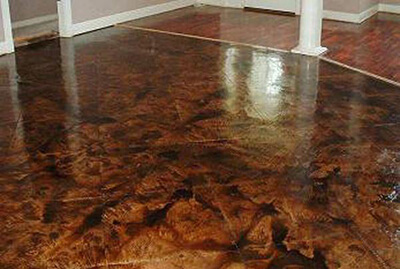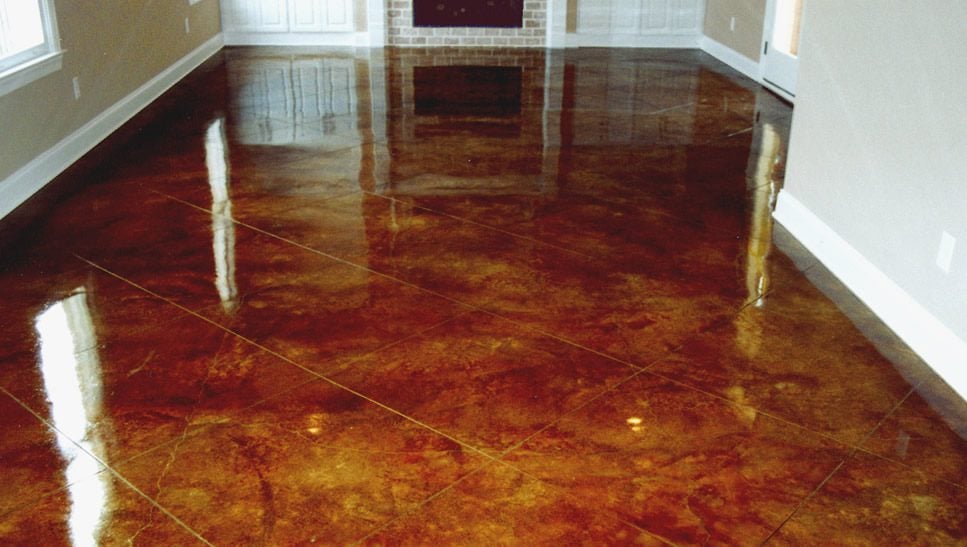Duration: What to expect during a stained concrete austin project
Wiki Article
Recognizing the Range of Services Offered in Flooring: Highlighting Stained Concrete Techniques
Stained concrete has actually become a compelling floor covering alternative for different areas. Its convenience exists in the option between acid and water-based stains, each supplying unique looks. Appropriate preparation and recurring maintenance are important to guarantee its sturdiness and look. As the need for ingenious flooring solutions expands, understanding the subtleties of discolored concrete techniques can open up new opportunities for both property and business atmospheres. What unique advantages might this floor covering option give a project?The Fundamentals of Stained Concrete
Stained concrete offers as a flexible flooring choice that combines resilience with visual appeal. This floor covering technique includes using a specially developed stain to the concrete surface, which permeates and alters the color of the product. The process not only boosts the visual elements of concrete yet likewise supplies the benefit of shielding it from damage. Stained concrete can achieve a variety of looks, from earthy tones to lively tones, making it suitable for different design styles.Appropriate prep work of the concrete surface is essential for suitable outcomes. This may include cleansing, grinding, or etching to assure the stain adheres effectively. Additionally, the application process normally entails using tools such as sprayers or brushes to achieve uniform protection. After staining, a sealant is often put on enhance toughness and keep the vibrancy of the shade. Ultimately, stained concrete provides an attractive and lasting flooring service for domestic and industrial areas alike.
Sorts of Stains: Acid vs. Water-Based

In contrast, water-based stains use a larger array of colors and are much easier to apply. They do not respond chemically with concrete yet rather provide a surface tint - stained concrete austin. Water-based discolorations are reduced in volatile organic compounds (VOCs), making them more ecologically friendly and ideal for interior tasks. While they might not provide the same depth of shade as acid discolorations, their flexibility and convenience of usage make them appealing for different applications. Inevitably, the selection relies on the job's demands, preferred aesthetics, and location
Strategies for Staining Concrete
The techniques for tarnishing concrete differ substantially in between acid and water-based approaches. Acid staining includes a chemical response that produces distinct, variegated colors, while water-based discolorations supply a more comprehensive combination and less complicated application. Recognizing these processes is essential for achieving the wanted visual in concrete flooring.Acid Staining Process
Acid staining offers a vibrant means to improve the aesthetic allure of concrete surface areas. This process entails using a mix of water, hydrochloric acid, and pigments to the concrete, which reacts chemically to generate dynamic, translucent shades. The concrete surface area should be thoroughly cleansed and prepped to guarantee ideal bond. Once used, the acid stain penetrates the concrete, developing special marbled results as it responds with the lime in the concrete. After the desired shade develops, the surface area is neutralized and washed to halt the response. Finally, a sealant is applied to shield the finish and boost toughness. Acid staining not just transforms the appearance of concrete yet likewise provides a lasting remedy for ornamental floor covering.Water-Based Staining Benefits
Exactly how can water-based staining boost the aesthetic and functional high qualities of concrete surface areas? Water-based spots supply a flexible remedy for enhancing concrete, giving dynamic shade choices while assuring environmental safety. Unlike acid spots, water-based alternatives penetrate the surface, enabling for also color circulation and an array of coatings, from matte to glossy. Furthermore, they are reduced in unpredictable organic compounds (VOCs), making them less harmful to indoor air high quality. Their quick drying out time promotes much faster task conclusion, while their resistance to fading ensures resilient appeal. Water-based discolorations can additionally boost the concrete's durability and resistance to stains, making them an optimal selection for both household and business applications. Inevitably, they provide a sustainable, attractive solution for various concrete surface areas.Layout Opportunities With Stained Concrete
Stained concrete deals a variety of style possibilities that can improve any space. Techniques such as color variation, various surface area ending up alternatives, and custom design patterns enable distinct and individualized floor covering options. These components not just raise visual appeals but likewise add to the total functionality of the concrete surface.Shade Variant Methods
discover this While discovering the design possibilities of stained concrete, color variation strategies play a crucial function in enhancing both visual charm and functionality. These techniques permit the development of unique patterns and results that can change an easy concrete surface area into a visually striking element of an area. Options such as acid staining, which responds chemically with the concrete, produce abundant, translucent tones that simulate all-natural stone. Water-based stains use a wider shade combination and permit more control in layout. Layering different spots can create depth and measurement, providing a tailored look. By incorporating color variation methods, designers can attain diverse designs, from rustic to contemporary, making certain that discolored concrete fits perfectly right into any style system.Surface Area Finishing Options
The exploration of color variant strategies sets the stage for taking into consideration surface ending up alternatives, which significantly influence the overall look and performance of tarnished concrete. Various finishes can improve the visual charm and durability of the surface. Typical choices consist of matte, satin, and shiny coatings, each giving a distinct visual effect. Matte surfaces use a subtle, understated beauty, while satin coatings strike a balance in between luster and practicality, making them popular for domestic and commercial spaces. Glossy finishes, on the other hand, create a high-shine appearance, boosting shade vibrancy and light representation. In addition, surface area therapies such as sprucing up or sealing even more improve durability, making these completing choices necessary factors to consider in creating practical and visually appealing stained concrete floors.
Custom Layout Patterns
Just how can personalized layout patterns boost the allure of discolored concrete? By integrating distinct designs, stained concrete can change ordinary floor covering right into a striking aesthetic statement. Customized patterns, such as geometric shapes, elaborate themes, or organic styles, permit personalization, making spaces really feel tailored and inviting. Customers can select from a variety of strategies, consisting of saw cuts, patterns, or overlays, to achieve wanted impacts. Additionally, integrating multiple shades with different stain strategies boosts the depth and measurement of the patterns. These style opportunities not just improve aesthetic allure however also boost the value of household or business spaces. Inevitably, customized design patterns give a possibility for creative thinking, setting tarnished concrete besides traditional flooring alternatives.Preparing Your Concrete Surface
Correct preparation of the concrete surface area is vital for attaining a successful tarnished finish. This process starts with comprehensive go to website cleansing to remove dust, grease, and any type of various other contaminants. A pressure washing machine or a flooring scrubber can efficiently remove these substances, making sure a fresh start for staining. After cleaning, it is important to fix any kind of cracks or flaws in the concrete. This can be completed using a concrete patching compound, which must be allowed to cure totally prior to continuing.As soon as the surface is clean and repaired, grinding or sanding may be needed to produce a smooth, also texture. This step enhances the concrete's capability to take in the stain consistently. Ultimately, a concrete etcher can be related to open the pores of the surface, enabling for much better bond of the stain (stained concrete). By complying with these preparation steps, the resulting stained concrete will exhibit a more vibrant and lasting finish
Upkeep and Look After Stained Concrete
Keeping tarnished concrete is essential for protecting its appearance and longevity after the first prep work and application of stain. Routine cleaning is essential; sweeping or vacuuming to remove dust and particles protects against scrapes and dullness. For deeper cleansing, a light pH-neutral cleaning agent blended with water can be used, adhered to by thorough washing to prevent residue buildup.Securing discolored concrete is another key upkeep step, as it safeguards the surface from discolorations and wetness. Depending on the sealer kind, reapplication might be needed every one to three years. In addition, preventing severe Source chemicals and abrasive devices helps maintain the stability of the stain.
For outside stained concrete, it is suggested to clear snow or ice immediately to avoid damage from freeze-thaw cycles. On the whole, constant care assurances that stained concrete maintains its dynamic color and architectural stability over time, making it a durable flooring selection.

Price Factors To Consider for Stained Concrete Floor Covering
When reviewing the price of tarnished concrete floor covering, prospective house owners commonly question regarding the different elements that influence rates. Trick factors to consider include the size of the location to be covered, the intricacy of the style, and the kind of stain used. Standard staining strategies have a tendency to be a lot more cost effective, while complex patterns or several colors can substantially raise expenses.
Geographical area is another element, as prices can vary commonly from one area to one more. Ultimately, recurring upkeep prices must be factored in, as sealers and safety layers might be essential with time to maintain the visual and toughness of the tarnished concrete.
Often Asked Questions
Can Stained Concrete Be Applied Over Existing Floor Covering?
The question of whether discolored concrete can be used over existing flooring is often asked. Usually, it is possible, offered the underlying surface area is clean, steady, and suitable for appropriate attachment of the discolored concrete.The length of time Does the Staining Refine Take?
The staining procedure usually takes a couple of hours to a full day, relying on the dimension of the area and the complexity of the layout. Curing may call for additional time before the surface area is totally usable.Is Stained Concrete Suitable for Outdoor Usage?
Stained concrete is undoubtedly ideal for outdoor use, as it stands up to numerous climate condition. Its longevity and visual appeal make it a prominent selection for patio areas, walkways, and driveways, enhancing both capability and visual interest.
Can I Change the Color of Stained Concrete Later?
The ability to alter the color of discolored concrete later depends upon different aspects, consisting of the initial stain kind and surface area prep work. Consulting a specialist can provide guidance on potential options and outcomes for color alteration.Are There Eco-Friendly Options for Stained Concrete?
The inquiry regarding environment-friendly alternatives for tarnished concrete exposes an expanding rate of interest in sustainable building techniques. Several firms currently use low-VOC spots and ecologically friendly sealers, making certain visual charm while lessening ecological effect.Report this wiki page